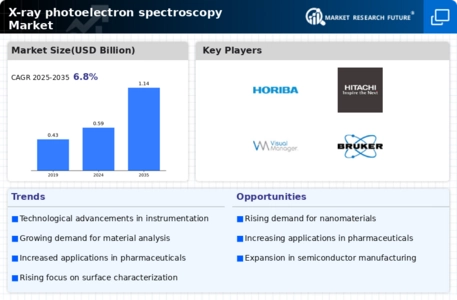Market players are investing heavily in R&D to expand their product range and this will help the X-ray photoelectron spectroscopy market grow further. Entrepreneurs also engage in a variety of activities to expand their international orientation, and important business development processes include new product development, contractual agreements, joint venture mergers and acquisitions, additional investments, and partnerships with other organizations. To thrive and survive in a more competitive and evolving business environment, the X-ray photoelectron spectroscopy industry must provide quality products.
Local manufacturing to reduce operating costs is one of the key business strategies adopted by companies in the X-ray photoelectron spectroscopy Market to benefit their customers and expand their business. In recent years the X-ray photoelectron spectroscopy industry has provided some of the best results in the medical field.
Major players in the x-ray photoelectron spectroscopy market, including Olympus Corporation (Japan), SUZHOU LANScientific Co., Ltd. (China), Hefei Jingpu Sensor Technology Co., Ltd. (China), HORIBA, Ltd. (Japan), Hitachi, Ltd. (Japan), Fischer Technology Inc. (U.S.), Dandong Dongfang Measurement & Control Technology Co., Ltd. (China), The British Standards Institution (U.K.), Bruker (U.S.), Bourevestnik (U.S.), SPECTRO Analytical Instruments GmbH (Germany), Applied Rigaku Technologies, Inc. (Japan), FAST ComTec GmbH (Germany), Malvern Panalytical Ltd (U.K.).
Shimadzu Scientific Instruments Corporation is a subsidiary of Shimadzu Manufacturing Co., Ltd. is a manufacturer of analytical and scientific instruments headquartered in Kyoto, Japan. With a rich history dating back to 1875, Shimadzu has become a global leader in the development and manufacturing of advanced analytical and measurement equipment. The company's products include a variety of scientific instruments such as chromatography systems, mass spectrometers, spectroscopy systems, environmental monitoring equipment and measuring instruments. In April 2022, Shimadzu Scientific Instruments, Inc. and Shimadzu Corporation formed a strategic alliance aimed at significantly enhancing the scientific data value for pharmaceutical companies.
This will be achieved by leveraging the capabilities of Tetra R&D, Data Cloud, and LabSolutions Software.
JEOL Ltd. is a prominent Japanese multinational company that specializes in the development and manufacturing of scientific and medical instruments., JEOL has established itself as a leading provider of electron microscopes, mass spectrometers, nuclear magnetic resonance (NMR) spectrometers, and other high-end analytical instruments. The company's electron microscopes are renowned worldwide for their advanced imaging capabilities, used in various fields such as materials science, life sciences, and nanotechnology. JEOL's mass spectrometers are vital tools for chemical analysis, aiding researchers in identifying and quantifying compounds with high precision.
JEOL Ltd. recently developed and launched the JSM-IT510 series, a state-of-the-art scanning electron microscope (SEM), in November 2021.








Leave a Comment